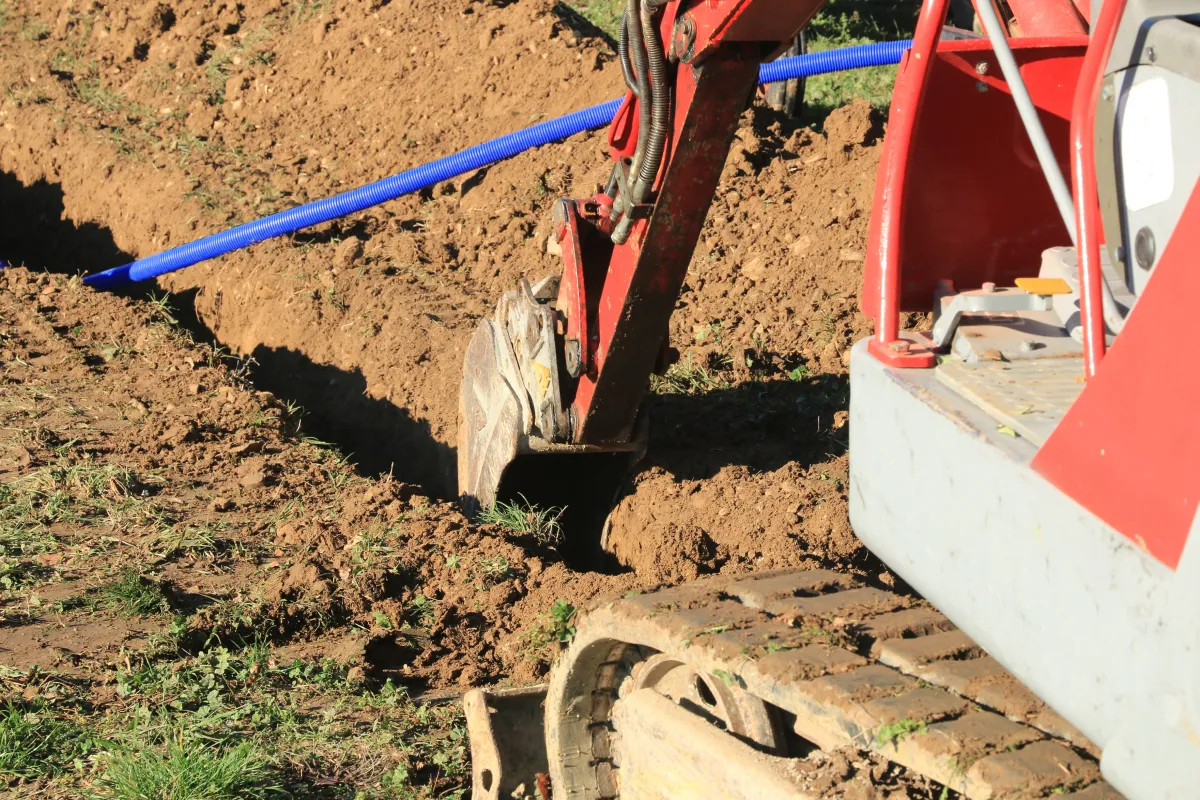Trenching Near WI, MN, IA
Why Precision Trenching Sets the Stage for Everything That Follows
Trenching is the foundation of nearly every underground system—whether you’re installing power, water, sewer, or drainage lines. A well-executed trench creates a direct, stable path for critical infrastructure while avoiding unnecessary surface damage. When done right, it reduces rework, keeps your layout on track, and simplifies every step that comes after.
But not all trenching is created equal. Soil type, depth requirements, slope, and access all impact how trenches should be dug and where they should go. The smallest miscalculation can affect pipe grades, utility flow, or future inspections.
This page explains what trenching actually involves, where it fits into broader site planning, and why it’s more than just a line in the dirt. Whether you're prepping for service lines, storm drains, or conduit runs, proper trenching saves time and prevents costly surprises.
How Can We Help?

Betts Utility Contractors LLC is Committed to superior quality and results!

AVOID COSTLY MISTAKES:
Do NOT hire an excavating contractor without first reading our free guide:
The ULTIMATE Excavation & Septic "Success Guide."


What Trenching Actually Involves
Trenching means digging narrow, often long excavations to create space for utilities, drainage, or foundations. These trenches need to be consistent in depth and width to meet code and match the system being installed. Depending on the goal, they may also need to slope or step to allow proper flow.
Every trench is part of a bigger design—tied into elevations, setbacks, and surface features. If the depth is off or the route changes slightly, everything from utility boxes to manholes can shift out of alignment. That’s why layout and execution go hand in hand.
It's Not Just the Dig—It's What Comes Next
Once the trench is open, it still has to accept conduit, pipe, or cable—and support backfill, compaction, or inspection. Clean, properly shaped trenches reduce install time and support long-term durability.
Common Trenching Applications
Utility Service Lines
From electrical to telecom to gas, most buried services need trenching to move safely across a property. Keeping lines at proper depth and spacing protects them from future disruption.
Drainage and Stormwater Management
Trenches are used to carry water away from buildings, roads, or landscapes. Sloping the trench correctly ensures flow without ponding or erosion.
Foundation Footing and Underground Framing
Trenching may also be used for footing forms or slab edges in new construction. Accuracy at this stage ensures the structure is built on a level, stable base.
Who Uses Trenching Services
General Contractors and Builders
Whether it’s for a custom home or a large-scale project, trenching is one of the first steps on the site. Getting it right early makes every other trade’s job easier.
Municipal and Utility Agencies
City work often requires trenching across sidewalks, medians, or road shoulders. Crews rely on accurate trenching to minimize surface disruption and maintain code compliance.
Property Developers and Site Prep Teams
Trenching helps prepare subdivisions, commercial pads, or rural builds for underground infrastructure. It ensures every connection is in place before vertical construction begins.
See Our Excavation & Hydrovac

✔️ Utilities Trenching
✔️ Trenching
✔️ Hydro Excavation
✔️ Daylighting/Potholing Services
Quality Services Launched FAST!

✔️ Hydrovac Services
✔️ Remote Hose Excavation
✔️ Utility Pole Hole Digging
✔️ Catch Basin Cleaning
What Are You Waiting For?
How Trenching Supports Flow, Function, and Future Access
Why Trench Depth and Grade Can’t Be an Afterthought
A trench that’s too shallow risks exposure; one that’s too deep wastes material and effort. But the most common issue comes from incorrect grading—where flow-based systems like drains or sewer lines don’t run properly. Getting depth and slope right is essential to long-term system performance.
Planning Ahead for Crossings and Access Points
Good trenching means thinking about more than just the dig. Crews must consider crossings, junctions, future tie-ins, and elevation shifts before a shovel hits the ground. These details affect everything from utility inspections to future repairs.
Cutting Corners Only Creates More Work
A trench that doesn’t meet spec may pass for now—but it will likely lead to costly corrections later. Sloppy work at this stage often shows up when systems don’t connect, fail to flow, or can’t be accessed.
When Trenching Solves More Than One Problem
Direct Routing for Underground Utilities
Trenching offers a controlled, visible path for running buried services across open ground or complex sites. It simplifies line layout and confirms utility placement before anything is installed. This reduces rerouting and saves installation time.
Surface Water Diversion and Erosion Control
In areas prone to runoff or soft ground, properly trenched drainage channels redirect water safely. When paired with fabric or rock fill, they also reduce erosion. This helps stabilize the site before and after development.
Separation of Conflicting Infrastructure
Trenching allows planners to place systems—like water and gas—at the correct distances to avoid interference. It also helps keep repair access open for the future. Separation today prevents complications tomorrow.
Where Trenching Fits into Long-Term Planning
Early Site Development and Survey Alignment
Before anything is poured or framed, trenches guide elevations, setbacks, and service layouts. They serve as the physical outline of what’s to come. Getting them right ensures a smoother transition into construction.
Infrastructure Upgrades in Built-Out Areas
Older developments often require retrofitting or utility expansion. Trenching allows selective digging without disturbing entire zones. It’s an effective way to modernize without tearing everything out.
Scheduled Repairs and Utility Access
When existing lines need to be serviced, trenching creates a clean way to reach them. It avoids excessive digging and reduces the risk of damaging adjacent systems. A clean trench makes maintenance faster and more cost-effective.
Hours: 8-5 M-F
Extended hours by appointment only.
Address: Sparta, WI 54656
